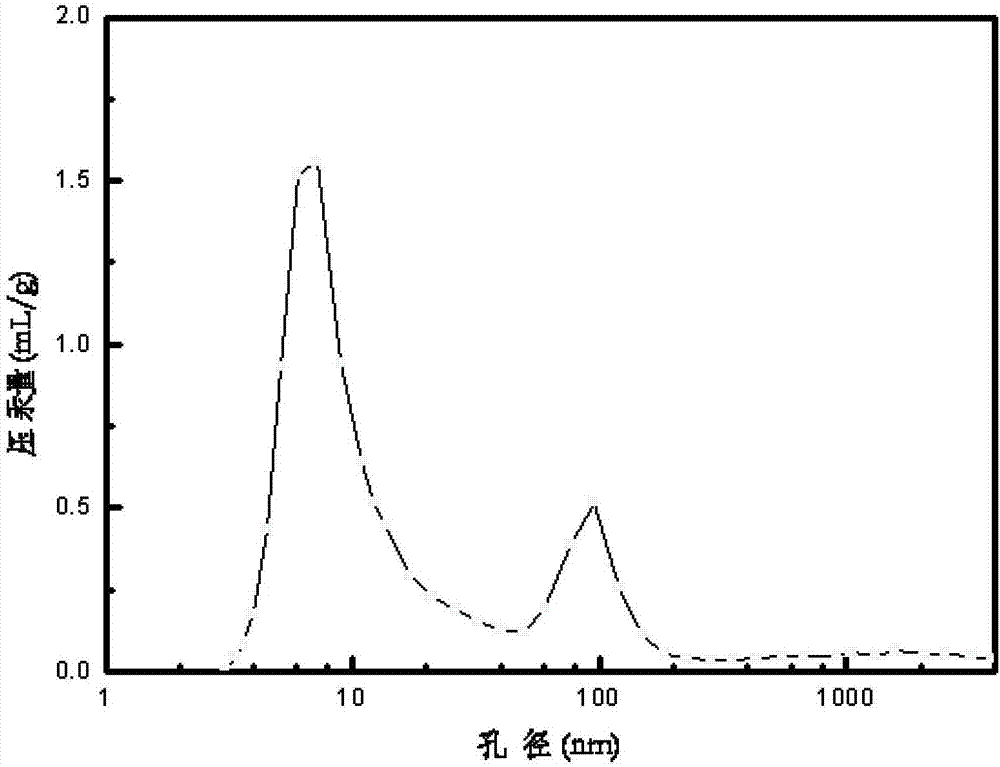Catalyst for FCC gasoline sweetening and preparation method thereof
A catalyst and desulfanization technology, applied in catalyst activation/preparation, chemical instruments and methods, physical/chemical process catalysts, etc., can solve the problem of inability to achieve controllable adjustment of macropore-mesoporous pore size, affecting product stability, and strong corrosion. problems such as stability, and achieve the effect of not easy coking and deactivation, increasing the proportion and good stability
- Summary
- Abstract
- Description
- Claims
- Application Information
AI Technical Summary
Problems solved by technology
Method used
Image
Examples
Embodiment 1
[0036] Firstly, 8.0 g of water-soluble chitosan pore expander was added to deionized water at 50° C., and then acetic acid was added dropwise until the chitosan was completely dissolved to obtain an acid solution containing the pore expander. Weigh 1.46 g of phosphoric acid and 7.35 g of magnesium nitrate, and completely dissolve phosphoric acid and magnesium nitrate in 70 g of distilled water to prepare an aqueous solution containing phosphorus and magnesium. Weigh 350g pseudo-boehmite powder and 20.0g sesbania powder into the kneader and mix them evenly, then add the mixed solution of phosphoric acid and magnesium nitrate, and finally add the acid solution containing chitosan to the pseudo-boehmite Evenly kneaded in the stone, kneaded and extruded into a clover shape. It was dried at 120°C for 8 hours and calcined at 700°C for 4 hours to obtain an alumina carrier 1 containing phosphorus and magnesium. The carrier 1 contains 0.5 wt% phosphorus pentoxide and 0.8 wt% magnesium ...
Embodiment 2
[0039] 8.0 g of a water-soluble chitosan pore expander was added to deionized water at 50° C., and then acetic acid was added dropwise until the chitosan was completely dissolved to obtain an acid solution containing the pore expander. Weigh 1.09g of phosphoric acid and 9.12g of magnesium nitrate, and completely dissolve phosphoric acid and magnesium nitrate in 70g of distilled water to prepare an aqueous solution containing phosphorus and magnesium. Weigh 350g pseudo-boehmite powder and 20.0g sesbania powder into the kneader and mix them evenly, then add the mixed solution of phosphoric acid and magnesium nitrate, and finally add the acid solution containing chitosan to the pseudo-boehmite Evenly kneaded in the stone, kneaded and extruded into a clover shape. It was dried at 120°C for 8 hours and calcined at 700°C for 4 hours to obtain an alumina carrier 1 containing phosphorus and magnesium. Then use phosphorus and magnesium to modify the surface of the carrier, configure an...
Embodiment 3
[0042] The preparation method of the carrier was carried out according to Example 1. The difference is that the auxiliary component in the carrier also contains cerium. The water-soluble chitosan pore expander is replaced with a non-water-soluble chitosan pore expander. The chitosan formic acid solution is stirred with a magnetic stirrer for 30 minutes to obtain Alumina support of macroporous structure 3. The content of the auxiliary components phosphorus, magnesium and cerium in the carrier are 1.8wt%, 2.0wt%, and 0.6wt% respectively. The specific surface area and pore size distribution are shown in Table 1.
[0043] Nickel nitrate and ammonium molybdate are prepared as an impregnation solution, ammonia water is added to adjust the pH value to dissolve the salt, and then the alumina carrier 3 is impregnated, dried at 130°C for 6 hours, and calcined at 750°C for 5 hours to obtain catalyst 3. The main components of the catalyst 3 are as follows: the alumina carrier with a macrop...
PUM
 Login to View More
Login to View More Abstract
Description
Claims
Application Information
 Login to View More
Login to View More - R&D
- Intellectual Property
- Life Sciences
- Materials
- Tech Scout
- Unparalleled Data Quality
- Higher Quality Content
- 60% Fewer Hallucinations
Browse by: Latest US Patents, China's latest patents, Technical Efficacy Thesaurus, Application Domain, Technology Topic, Popular Technical Reports.
© 2025 PatSnap. All rights reserved.Legal|Privacy policy|Modern Slavery Act Transparency Statement|Sitemap|About US| Contact US: help@patsnap.com


